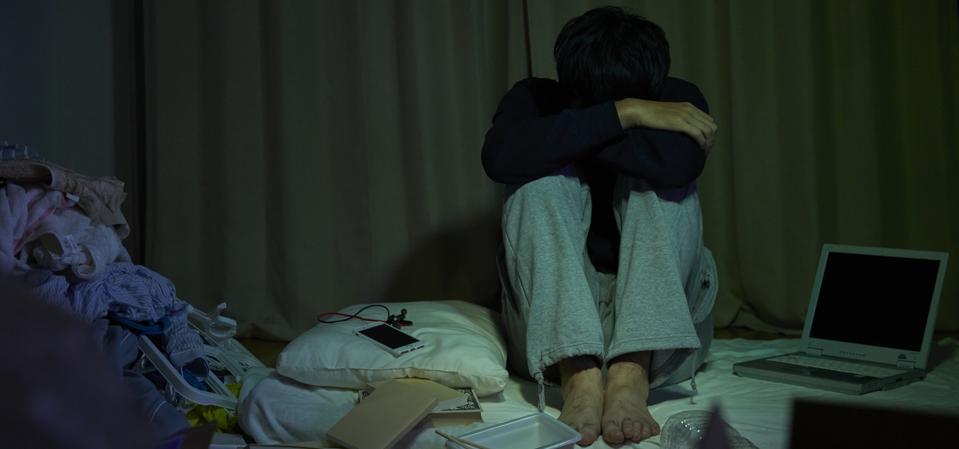“I became a hiki after dropping out of high school at 16,” writes a Reddit user, “I’m 37 now with the mind of a 16-year-old. Two decades and I’ve done nothing, never had a kiss, never got a job, just spent every day online. It does not get better.”
The term “Hikikomori,” originating from Japan, is a portmanteau of the words “hiki” (to withdraw) and “komori” (to be inside), collectively referring to “people who withdraw from society.”
Hikikomori is a cultural syndrome, studied extensively in Japan, now spreading worldwide with the widespread use of social media, exacerbating the already growing loneliness pandemic.
The Global Spread Of Hikikomori Syndrome
According to a 2023 study published in Clinical Child and Family Psychological Review, hikikomori is an extreme form of social withdrawal influenced by a range of factors including:
- Psychiatric conditions
- Maladaptive personality traits
- Adverse family dynamics, including detrimental parenting
- Negative peer experiences
- Societal pressures
- Excessive internet and digital media use
Hikikomori is marked by a persistent refusal to leave home for over six months, disinterest in most activities, dropping out of school, quitting work to stay indoors and dependency on one’s family without any future plans for self-reliance.
A 2022 Japanese cabinet survey uncovered that approximately 1.46 million recluses exist in Japan within the 15-64 age bracket. Additionally, a 2019 survey indicated that 613,000 Japanese adults between 40 and 64 also fell into the category known as “adult Hikikomori.”
The survey also sheds light on the concerning ”80-50 phenomenon” where parents in their 80’s are taking care of their children in their 50’s. Though the sample selection criteria were different in each survey, the implications are clear—all age groups are affected by hikikomori syndrome to some extent.
“What will he do when I’m gone or if I start having to rely on help from others?” says a 77-year-old widowed mother and survey participant, expressing concerns about her old age and leaving behind her 53-year-old alone without anyone to take care of him.
Just last year, South Korea’s Ministry of Gender Equality and Family launched a program offering a $490 monthly allowance to reclusive youth to reintegrate them into society, attend school and seek employment.
Furthermore, the syndrome is not solely confined to Japan but is gradually spreading to most digitally connected countries globally, including the USA, China, India, Brazil and other European countries.
Why People Become ‘Hikikomori’
A 2019 study published in the journal Frontiers of Psychology suggests that hikikomori is primarily associated with one’s interpersonal relationships and that such individuals also display suicidal risks factors. Another study suggests that being hikikomori is marked by:
- Hopelessness. Participants reported feelings of incompetence in a challenging world. Many feel traumatized by past experiences and expressed reservation around facing future real-world challenges.
- Relationship fatigue. Another reason people withdraw from society is due to negative experiences with people arising from their school, workplace or home. Some participants expressed that loneliness is less painful for them than dealing with other people.
- Inevitability and fear. “I am a weak person. I can only hide in the dark,” says one participant. The lack of alternatives and the apparent inevitability of their fate as a hikikomori seems to overwhelm such individuals, leading to struggles with low self-esteem, confidence and real-life interactions. The fear of judgment gripped some participants, contributing to their withdrawal as they were afraid of disappointing others and already felt like failures.
How To Reintegrate Hikikomori Back Into Society
It’s important to note that not all hikikomori are resistant to treatment; in fact, a significant number seek help but may be unsure how to access it or question their ability to do so. Research proposes that there is hope in the fact that many hikikomori individuals live with family members, suggesting that the healing journey can begin at home.
Here are three ways for hikikomori can, gradually and with care, start leaving their homes:
- Familial support. Parents of hikikomori can take proactive steps by altering their approach, shifting from reprimanding their children or issuing orders to patiently encouraging them to initiate conversations or take action. They may also benefit from attending family therapy, enhancing communication skills and adjusting their expectations, as progress can take time.
- Starting small. Starting with smaller, doable activities like leaving their room a few times a day to going for a walk early in the morning when no one is out or visiting a nearby store. Hikikomori can work on gradually venturing outside, leading to bigger changes with time.
- Mental health support. Online and offline communities can offer valuable support to individuals navigating challenging circumstances on their own. A therapist can play a crucial role in not only helping them address and navigate their struggles but also in providing compassionate guidance to aid in the recovery process.
The phenomenon of hikikomori underscores the critical importance of strong social support networks and prioritizing mental health awareness across the world. It is essential to create environments where individuals feel valued, supported and empowered to seek the help they deserve.
Curious whether you show signs of Hikikomori syndrome? Take this test to find out: Hikikomori Questionnaire

